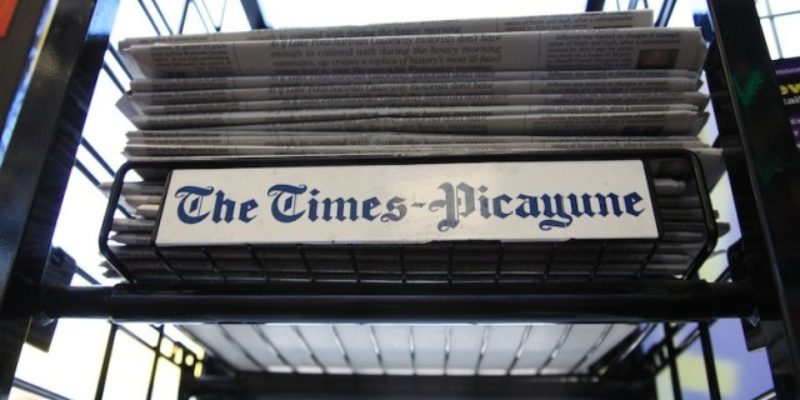And this is why Julia O’Donoghue no longer works in the print journalism industry.
The New Orleans Times-Picayune ceased to exist independently last weekend, which a few of its departing employees acknowledged in print. The blood bath was more than I predicted, with only a handful of staffers picked up by new the parent Baton Rouge Advocate.
One, who moved on to a radio gig in St. Louis, was former state legislative reporter Julia O’Donoghue. She wrote a piece revealing how she had loved her job, along with a couple of comments about politics and the press. (See how history disappears so quickly – it’s now available only in cached form.)
Almost all of it is unremarkable, except for a brief unmasking as a social justice warrior:
… it worries me that there is so little diversity in my industry. When I go to journalism conferences and look around at press events, I see a lot of people who look like me.
I don’t see many people of color. I don’t see many people who grew up in working class households or rural areas.
Journalists fancy themselves the spokespeople for the community. We are the ones who have full-time jobs as watchdogs monitoring government, but we don’t currently look enough like our communities for my comfort.
If everyone in our newsroom looks the same, then what are we as journalists missing? What questions are we not asking? We need to do better.
Which, actually, is completely wrong at least on the race account. It turns out, according to the latest data, that non-whites make up a quarter of all newspaper newsroom employees (although with a survey response rate of just one in six, possibly the sample is unrepresentative), which essentially reflects the country’s population. And, there’s more than a little conceit here with the declaration of journalists as “spokespeople” and serving as watchdogs, which fundamentally misses the point of journalism: journalists are reporters of news and not community advocates nor some unofficial fourth branch of government whose job is to prevent its official parts from careening off the rails.
But what’s entirely fascinating is the piece’s disconnection with the actual lack of diversification in the newsroom – political affiliation. By every measure, newsrooms suffocate under liberalism and partisanships loyal to the political left. According to the latest comprehensive survey (five years old), 28 percent claim the Democrat label compared to 7 percent Republican, but the real story comes from the 50 percent calling themselves independent and 15 percent labeling themselves “other.” You can bet few of this 65 percent vote for Republican candidates; an overwhelming majority settle for Democrats but hanker for socialists and beyond.
Advertisement
That conclusion, aside from anecdotal evidence, seems valid when reviewing the latest data on the ideological preferences of a subset in the profession, financial reporters. You might think the business orientation of such folks might lend itself to having a coterie better reflecting the American public, which ideologically divvies up as about a third conservative, a quarter liberal, and the rest in between.
Think again. A survey from last year showed financial journalists with liberal political views outnumber those with conservative political views by more than 13-to-1. Fewer than five percent gave themselves a conservative label, while almost 60 percent labelled themselves liberal.
And this lack of ideological and partisan diversity becomes supercharged by the tendency of working journalists to congregate in areas with political views deeply unrepresentative of the American public’s views. Or, as the authors note in a piece exposing this in relation to the 2016 presidential election, “If you’re a working journalist, odds aren’t just that you work in a pro-Clinton county – odds are that you reside in one of the nation’s most pro-Clinton counties.”
It produces a product not diverse in political orientation that already, because of changing mores in journalism, lends to more subjectivity and opportunity for bias in presentation. It’s not gone unnoticed; voters perceive the media put their thumbs on the scales when reporting on political contests in favor of Democrats and trust in the media has bounced only a bit from an all-time low.
This explains why the Times-Picayune went under. As newspapers nationwide continue to permit their parochial views to leak into their coverage at odds with a plurality of the public, that segment of their audience interested in hard news, especially of politics, don’t perceive their production of a quality product. Especially with the ubiquity of television news (which tends to have greater balance, especially at the local level) and the rise of online-only production (which a few years ago surpassed in number of employees those in print newsrooms and also provides more diverse alternatives) easily available on devices and all at no additional cost, print-based sources (increasingly demanding a subscription online) have become tolerated less and less.
Until the O’Donoghues of the world recognize that the real diversity problem in America’s newsrooms comes in the area of ideology, there’s no chance that the hemorrhaging in newspaper employment and revenues – down by nearly half and over half in 15 years up to 2017 – will cease. The tone deafness of her print media eulogy suggests that awakening won’t happen any time soon.
Advertisement
Advertisement

